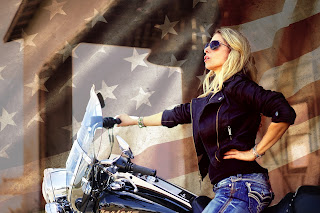FROM WAR HORSE TO IRON HORSE:
A History of the Horse in Battle and the Integration of the Motorcycle
by Joelle Fraser
Nearly 100 years ago, during the bitterly cold spring of 1916, the future of the American military would change forever.
 |
| Mexican Revolutionary General Poncho Villa |
But all that changed on March 9, when the revolutionary General Pancho Villa raided Columbus, New Mexico, for supplies. The raid did not go as planned: Villa's 500 cavalrymen were defeated by over 300 United States infantry and cavalry who were stationed in a border fort outside of town.
Sixty to eighty Villistas were killed, along with over a dozen American troops and civilians.
 |
| General John Pershing |
It happened quickly. Over the next eleven months, over treacherous mountains and barren landscapes, the campaign would be described by one historian as a “logistical nightmare—no roads, no maps, no water.”
The U.S. government was still a “horse army” at this time, using the animals to carry supplies and messages to the advancing troops, much as the animals had been used in warfare for over 5,000 years.
 |
| Horses have been used in warfare for 5000 years |
But the army hadn’t prepared for an expedition that would involve more than 700 horses and nearly 150 mules requiring six tons of hay and 9000 pounds of grain as daily feed. Officers had to go out in a car every morning to find and purchase corn and hay from local farmers.
Meanwhile, the 1st Aero Squadron was facing daily disaster trying to cross Cumbre Pass carrying dispatches and mail to forward troops—troops that would eventually penetrate 350 miles into Mexico. Relentless winter weather through early April, particularly icy nights at high altitude, made both pursuit and logistics difficult. An additional regiment of cavalry and two of infantry were added to the expedition in late April.
Lt. Herbert Dargue stated, “It is nothing short of criminal to send the aviators up under such conditions as we are meeting here.” The airmen were “risking lives ten times a day, but are not given equipment needed.”
 |
| A postcard of General Pershing's camp at Fort Bliss "Camping on the Border, near El Paso, Taxas" by Curt Teich & Co. |
Pershing, although a fine horseman often pictured astride his steed, could see the value of a mechanized force and the need for “maneuver warfare,” which emphasized speed and mobility. The horse, used in war for 5,000 years, was on its way out.
Trucks were ordered from seventeen truck companies—with chauffeurs and mechanics, because it was still too early for the common foot soldier to know about vehicles.
 |
| Harley-Davidson's Model 16-GC featured a sidecar gun carriage with a special platform for a Colt Machine Gun |
The motorcycles could quickly reach downed aircraft in Mexico. Soon, motorcycles took over the routine message traffic, and the planes would be reserved for emergency use.
This Harley-Davidson Sidecar rig is preserved in original
condition, and features 61' IOE engine, and HD built side-hack.
condition, and features 61' IOE engine, and HD built side-hack.
But Mexico offered the perfect defensive positions for Pancho Villa, who knew the “country like the back of his hand,” according to one historian.
 |
| In 1917, American troops went to fight in WWI, and Poncho Villa was never captured |
Though a few of Villa’s top commanders were captured or killed, and his forces destabilized, Pancho Villas was still at large. However, in Europe, World War I was in full swing. In early 1917, as war loomed between the United States and Germany, President Wilson recalled the army.
General Pershing and his men left the dusty desolate landscape behind, saying, “Villa is everywhere and Villa is nowhere.”
The Poncho Villa Expedition had turned the tides of war, and the vehicle—including the quick and agile motorcycle—would be the go-to tool of the U.S. Army until today.
 |
| Motorcycles in Desert Storm |





Love it so informative, great photos to go with it. Great job.
ReplyDeleteLove it so informative, great photos to go with it. Great job.
ReplyDeleteThanks!!!
DeleteVery enjoyable since I love history, and this side of the story is rarely told. Good job.
ReplyDeleteThanks so much--I didn't know about this, either. I knew about bikes in WWI and WWII mostly.
DeleteGreat story, very informative....
ReplyDelete